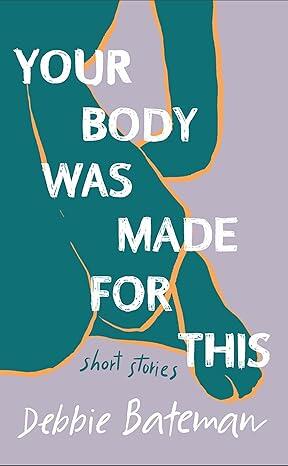
Reckoning and Reclaiming
Your Body Was Made For This, Debbie Bateman, Ronsdale Press, 2023.
Vancouver Island writer Debbie Bateman’s first collection of short stories, Your Body Was Made for This, follows in the tradition of Margaret Laurence’s unforgettable Hagar Shipley and Sharon Butala’s older women protagonists. Midlife presents an opportunity for the characters to reckon with and reclaim their lives, and Bateman’s collection of linked short stories explores older women’s experiences of their own bodies and their relationships.
Who are women’s bodies for? The lives of Bateman’s characters respond to this question. The titular story, “Your Body Was Made for This,” tells the story of Brianne, and Bateman’s use of a detached third-person point of view underscores how the world views Brianne in terms of her reproductive potential. Brianne’s postpartum sister pressures her to have children of her own. Brianne’s body is assaulted by a man and, later, by cancer. Despite these traumas, she forms a lifelong relationship with a decent man, and the story ends with the pair in their seventies running naked into a glacial lake: “Afterwards [. . .] She runs her fingers through his grey hair. He kisses the scars on her chest [. . .]They meet skin to skin, and unafraid, in the open air.” (52) In various ways, the women in the stories eventually assert their sovereignty over their own bodies.
“The Point of Failure” explores the politics of women’s body size. Grace comments that at night, her husband’s body “offer[s] a thin chill that never seem[s] to warm [. . .] his body st[eals] all my heat.” (67) One of the main themes of the collection is women reclaiming the life force that others have taken from them. Food hoarding is a way for Grace to have something of her own. She is “put [. . .] on a diet” by her partner, but she begins working out at the gym of her own accord: “I think I tried it because Jayden had nothing to do with it. My idea, my butt.” (57-8) Fitness progress is described as “the repair of microscopic tears,” an apt metaphor for women’s resistance to the ways
our society tears them down in acts both macro and micro. Ridiculed publicly for her size, Grace asks rhetorically, “Because I’m fat, does that make me public property?” (72)
In the opening story, “Secret Workings,” Pauline’s conflicted relationship with her body due to sexual abuse in childhood is further complicated by the attitude of her husband. When she initiates sex during her menstruation, he responds, “’Please, no. I’d rather not [. . .] Let’s wait until you’re clean.’” (12) Here, Bateman creates voice to good effect. Pauline reflects, “Three decades of decorating, sweeping and polishing, rearing a daughter who’d the good sense to get out already, and sharing meal after meal with Mystery Man in a smartly tailored suit. What for?” (2) Pauline’s word choice reveals a survivor with a sardonic sense of humour as well as her alienation from her own life. She begins taking yoga classes, and, over time, her body frees itself from the trauma of abuse. Having decided to end her marriage, Pauline packs her suitcase, but at the last moment she decides her husband should be the one to leave, since she loves her house. As she tells him this, “she steps tenderly inward toward her true home” (18) — her own body, now an ally.
Bateman also explores the journey from object to subject through women reclaiming sexual desire. In “The Art of the Scarf,” Helena notes that “until recently, she’d only ever worn [a scarf] under a winter coat to buffer against the cold, nothing so precious it couldn’t be stuffed into an empty sleeve for safekeeping. Yet, recently, she spent an entire afternoon in boutiques, wrapping and unwrapping gossamer veils over her shivery skin.” (18) Here, Bateman uses the scarf to symbolize the protagonist’s self-regard. Helena is having an affair with her boss, even though she’s more-or-less happily married to a man she’s been with since high school, whose own earlier sexual infidelity Helena has forgiven, or so she believes. Helena’s affair reawakens her long-dormant sexual desire, including for her husband. Although she ends the affair, she never tells her husband about it. Helena’s agency reinvigorates their relationship. As she undresses with her husband, “she gradually unwinds her black silk scarf, turns down her eyes, afraid to be vulnerable but yielding to that urgent need to be touched.” (37) During sex, her husband “never realizes his wife is watching or that sometimes she touches lightly on a body memory of another man, not because she misses him, but to find again her uncovered self, to bring their relationship back into balance.” (37) She is now careful to keep something of herself for herself.
Bateman’s collection also explores the way mother-daughter relationships are complicated by patriarchy. In “Sundowning,” Pauline helps her mother clear away Pauline’s dead father’s belongings. Her mother has never acknowledged the abuse perpetrated on her daughter by her husband, and as she is now experiencing dementia, reconciliation seems unlikely. However, although she no longer knows who Pauline is, the story ends with her lamenting to someone else in Pauline’s presence, “’My sweet little girl. She was my whole life . . . and he took her from me. I hate him.’” (202) Although it’s too late for reconciliation, this powerful moment provides Pauline with evidence of her mother’s love for her.
Although they often struggle with forces beyond their control, the women in these stories are not simply victims or even survivors, but fully fleshed human beings, flaws and all. They conduct “an honest and fearless inventory” (181) of their lives. In “The Love Drug,” Hanna struggles with addiction, lamenting its effects on her relationship with her adult son. She views his trust in her as a mistake, beginning when he was an infant and continuing in the present: “I didn’t know how to warn him” (159), depicting a self-loathing common amongst women who feel they must meet mothering standards that deny them permission to have human flaws.
In a number of the stories, Bateman toggles back and forth between two third-person-limited points of view. In “Intimacy,” a couple mourns their fading passion for one another, and the narrative switches back and forth between the two people in a way that seems deliberately disorienting, reflecting their mutual sorrow about their disintegrating relationship. However, this switching of point of view works less well in “Double Zero” and “Crossing the Line,” where the uncertainty about which character has the narrative doesn’t seem to add as much as it does in “Intimacy.”
This is a small quibble, though. Overall, I was engaged and moved by Bateman’s collection. The loosely linked structure of the stories draws readers into the world of the characters and explores them as multi-faceted human beings. I feel like I know these women, and I recognize aspects of myself in them. I’m on their side as they move into the fullness of themselves and their lives.
— Janet Pollock Millar writes in multiple genres in Victoria, BC.











